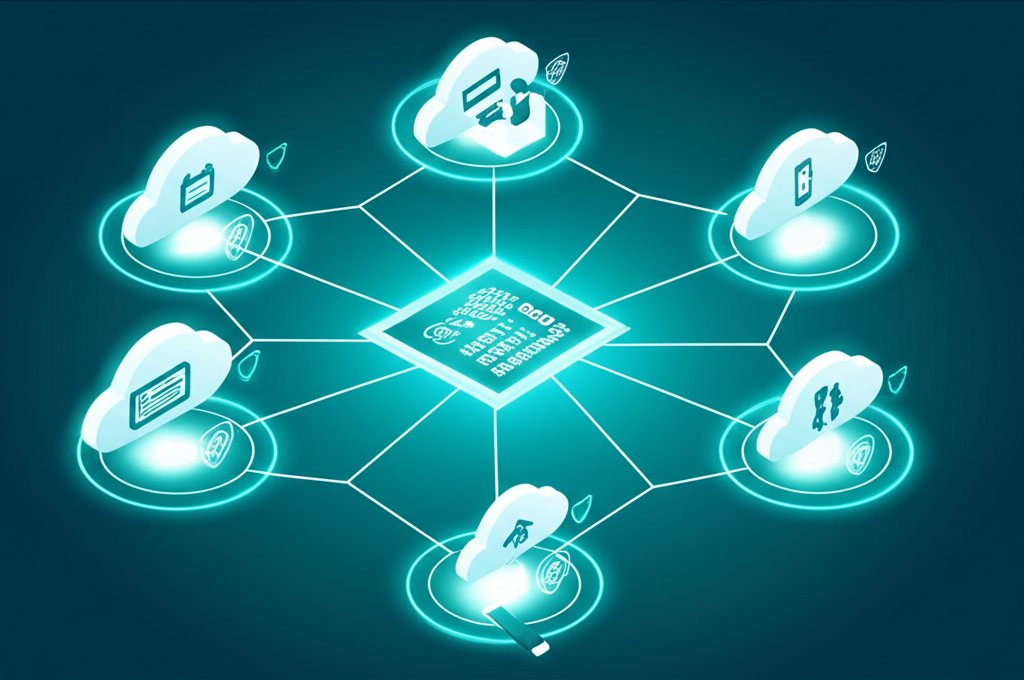How Zero Trust Architecture Streamlines SOC 2 Compliance for Small Businesses
For many of us in the security sphere, the pressure to maintain robust data security and achieve compliance, particularly something as comprehensive as SOC 2, isn’t just a challenge for the tech giants. It’s a critical, often daunting, reality for organizations of all sizes. As security professionals and developers, you’re likely wrestling with how to build secure systems that not only protect sensitive data but also stand up to rigorous auditing. SOC 2, with its focus on how a service organization manages customer data based on the five Trust Service Criteria (TSCs), can feel like a labyrinth of requirements.
But what if I told you there’s an architectural paradigm that can inherently streamline this process, moving you from reactive firefighting to proactive security engineering? Enter Zero Trust Architecture (ZTA). It’s more than a buzzword; it’s a security philosophy—a mindset of “never trust, always verify”—that, when implemented thoughtfully, can surprisingly make your SOC 2 compliance journey more manageable and less reactive. We’re going to demystify both SOC 2 and Zero Trust from an architectural perspective, demonstrating how a ZTA approach provides a strong, auditable foundation that simplifies your path to compliance. You’ll see, it’s about building security in, not bolting it on.
The Core Shift: From Castle-and-Moat to Zero Trust Principles
Traditional security models, you’ll remember, operated like a castle: strong perimeter defenses and implicit trust once you were inside. That approach simply doesn’t cut it in our modern, distributed, cloud-centric world where the “perimeter” has dissolved. Zero Trust flips this on its head. It operates on the core principle that no user, device, or application should be inherently trusted, regardless of its location relative to a network boundary. Every access request must be explicitly verified and continuously validated.
From an architectural standpoint, Zero Trust isn’t a single product; it’s a strategic framework built upon several foundational pillars:
- Explicit Verification: This is where every access request is rigorously authenticated and authorized. We’re talking Multi-Factor Authentication (MFA) for all identities, strong identity governance, and continuous assessment of device posture (health, patch status, configuration compliance). You must know who (or what) is requesting access, where they’re coming from, and the state of their device.
- Least Privilege Access: Users and systems should only have the absolute minimum permissions necessary to perform their function, for the absolute minimum time required. No more “admin by default.” This principle helps you architect granular access controls that severely limit potential damage from a compromised account.
- Micro-segmentation: This involves breaking down your network into small, isolated security zones, often down to individual workloads or even specific functions. If one segment is compromised, the breach is contained, preventing lateral movement. Imagine logically locked compartments on a ship; a breach in one doesn’t sink the whole vessel. This massively reduces your attack surface.
- Continuous Monitoring & Validation: Security isn’t a one-time check. All access requests, user behaviors, system activities, and data flows are continuously monitored for anomalies. This validates policy adherence in real-time and provides invaluable audit trails crucial for compliance.
- Assume Breach: Operate with the mindset that a breach will happen. This encourages you to design for resilience, rapid detection, and quick response, rather than solely focusing on prevention. It shifts your focus to minimizing impact and ensuring rapid recovery, which profoundly impacts your incident response and business continuity planning.
-
Identity & Access Management (IAM): This is the cornerstone of ZTA. We’re talking about robust identity providers (IdPs) that support mandatory MFA, Single Sign-On (SSO), Role-Based Access Control (RBAC), and ideally Attribute-Based Access Control (ABAC). Your IAM solution needs to be the authoritative source for all user and service identities, ensuring that every “who” is known and verified.
- Example: Azure Active Directory (now Entra ID), Okta, AWS IAM.
-
Device & Endpoint Security: Beyond traditional antivirus, ZTA demands Endpoint Detection and Response (EDR) solutions that can assess device posture (e.g., patch status, configuration compliance, presence of malware) and enforce security policies before and during access to resources. This ensures the “what” (device) is also trustworthy.
- Example: CrowdStrike Falcon, Microsoft Defender for Endpoint, SentinelOne.
-
Micro-segmentation & Zero Trust Network Access (ZTNA): These components enforce granular network policies, often down to the application layer. Micro-segmentation can be achieved through software-defined networking (SDN), network access control (NAC), or cloud-native network security groups. ZTNA gateways provide secure, policy-based access to specific applications rather than entire networks, replacing legacy VPNs.
- Example: Illumio, Palo Alto Networks’ GlobalProtect, Google’s BeyondCorp, Cloudflare Zero Trust.
-
Data Security: Encryption at rest (e.g., database encryption, S3 bucket encryption) and in transit (TLS everywhere) is non-negotiable. Data Loss Prevention (DLP) solutions are also critical for monitoring and preventing sensitive data exfiltration, ensuring that even if an unauthorized party gains access, the data remains protected or is prevented from leaving controlled environments.
- Example: AWS KMS, Azure Key Vault, Proofpoint DLP, native DLP features in Microsoft 365/Google Workspace.
-
Logging & Monitoring (SIEM/XDR): Centralized logging and Security Information and Event Management (SIEM) or Extended Detection and Response (XDR) systems are vital. They aggregate security logs from all ZTA components, enabling continuous analysis and alerting for suspicious activities, policy violations, and potential breaches. This provides the “eyes and ears” for your continuous validation.
- Example: Splunk, Microsoft Sentinel, Elastic SIEM, Datadog Security Platform.
-
Policy Enforcement & Orchestration: Dedicated policy engines are needed to define, manage, and enforce Zero Trust policies across identities, devices, and resources. Automation tools can orchestrate responses to policy violations, such as revoking access or isolating a device. These are the “brains” of your ZTA, translating your security intent into actionable controls.
- Example: Custom policy engines, integrating with Cloud Security Posture Management (CSPM) tools, or native cloud policy services (e.g., AWS Organizations SCPs, Azure Policies).
- Explicit Verification (IAM & MFA): By requiring MFA for all access and continuously verifying user and device identities, ZTA directly addresses SOC 2’s rigorous access management requirements. Auditors can easily review policies that mandate MFA, strong password controls, and robust identity lifecycle management, with logs providing undeniable proof of enforcement.
- Least Privilege Access: ZTA’s emphasis on granting only the minimum necessary permissions means you have a robust framework for managing user roles, access to sensitive data, and system configurations. This simplifies demonstrating that access to critical systems and data is tightly controlled and regularly reviewed, a key aspect of the Security criterion.
- Micro-segmentation: Segmenting your network and applications into isolated zones significantly strengthens network security. Auditors will appreciate how ZTA contains potential breaches, preventing lateral movement and limiting the scope of any compromise, thus protecting the integrity and confidentiality of data within other segments.
- Continuous Monitoring & Validation (SIEM/XDR): The constant logging and analysis of all activities provide rich audit trails. This evidence directly supports the Security criterion by demonstrating active detection of anomalies, unauthorized access attempts, and policy violations. Your ability to quickly identify and respond to threats is a massive audit advantage.
- Assume Breach: This mindset drives resilient system design, focusing on detection and response. For SOC 2, this translates to clear incident response plans, documented recovery procedures, and tested business continuity plans – all crucial components of a strong security posture.
- Micro-segmentation: By isolating workloads and applications, ZTA prevents a compromise in one area from cascading into a widespread outage. If a component goes down or is attacked, its blast radius is contained, ensuring other services remain available. This is powerful evidence for auditors regarding your ability to maintain service continuity.
- Assume Breach & Incident Response: ZTA’s focus on anticipating and containing breaches means you’re building systems designed to recover quickly. Robust incident response plans, supported by continuous monitoring and automated remediation (part of ZTA orchestration), directly demonstrate your commitment to ensuring continuous service.
- Continuous Monitoring: Proactive monitoring of system health, performance, and security events, inherent in ZTA, allows you to detect potential availability issues (e.g., DDoS attacks, resource exhaustion) before they impact users, enabling swift intervention.
- Redundancy & Resilience: While not exclusively a ZTA principle, Zero Trust design encourages building redundancy and failover mechanisms into critical ZTA components (like IdPs or ZTNA gateways) to ensure that the security infrastructure itself is highly available.
- Explicit Verification & Least Privilege Access: By ensuring that only authorized individuals and systems, with verified identities, can initiate or modify data processing tasks, ZTA directly supports processing integrity. Granular access controls prevent unauthorized manipulation of data or system configurations that could lead to processing errors.
- Continuous Monitoring & Audit Trails: Every action within a Zero Trust environment is logged and monitored. This provides irrefutable evidence of who performed what action, when, and from where, allowing auditors to verify the integrity of processing activities and quickly identify any unauthorized or anomalous operations.
- Secure Inter-Service Communication: ZTA extends trust verification to inter-service communication. By enforcing strong authentication and authorization between microservices, you ensure that data passed between systems during processing remains valid and untampered.
- Data Security (in transit/at rest): Encrypting data during processing (in transit) and when stored (at rest) safeguards its integrity against unauthorized interception or modification, directly supporting the Processing Integrity criterion.
- Least Privilege Access: This is paramount for confidentiality. ZTA ensures that access to confidential customer data, intellectual property, or business secrets is restricted to only those roles and individuals who absolutely need it to perform their job functions. This directly fulfills the core requirement of preventing unauthorized disclosure.
- Micro-segmentation: Isolating confidential data stores and the applications that process them means that even if one part of your system is breached, confidential information in other segments remains protected and inaccessible.
- Explicit Verification: Requiring strong authentication (MFA) and continuous re-verification for any access to confidential resources means that only thoroughly validated identities can ever interact with this data.
- Data Security (Ubiquitous Encryption & DLP): ZTA mandates encryption for all sensitive data, both at rest and in transit. The implementation of DLP solutions further ensures that confidential information cannot be inadvertently or maliciously exfiltrated, providing robust technical controls against unauthorized disclosure.
- Least Privilege Access to PII: ZTA’s granular access controls are essential for privacy. They enable you to restrict access to Personally Identifiable Information (PII) to only those specific roles or systems authorized to handle it, minimizing the risk of unauthorized use or disclosure.
- Data Security (Encryption & DLP): The pervasive encryption of PII, combined with DLP policies, ensures that personal data is protected from unauthorized access or exfiltration. This provides strong technical assurances that your organization is upholding its privacy commitments.
- Continuous Monitoring & Audit Trails: Detailed logs of who accessed PII, when, and for what purpose, are critical for demonstrating compliance with privacy principles and for investigating any potential privacy breaches. ZTA’s continuous monitoring provides this granular visibility.
- Secure Data Retention & Disposal: While not a direct ZTA pillar, the architectural rigor of ZTA encourages clear data classification and robust controls around data storage. This naturally extends to implementing and verifying secure retention and disposal policies for PII, a key aspect of privacy compliance.
- Action: Inventory & Enforce Strong Identities.
- Identify All Users & Devices: Get a clear picture of everyone who needs access and what devices they use.
- Mandatory Multi-Factor Authentication (MFA): Implement MFA for all users, especially those with administrative privileges, across all critical applications (cloud services, internal tools). This is non-negotiable for SOC 2 Security.
- Centralized Identity Provider (IdP): Adopt a single sign-on (SSO) solution or leverage your cloud provider’s IAM service. This centralizes user management, simplifies access, and provides a single source of truth for identity.
- Accessible Tools:
- Cloud IdPs: Azure Active Directory (now Entra ID) offers free tiers or is included with Microsoft 365. Google Workspace provides robust identity features. Okta has affordable starter plans.
- Built-in MFA: Most cloud services (AWS, Google Cloud, Salesforce, Slack) offer built-in MFA.
- SOC 2 Impact: Directly addresses the Security criterion by significantly bolstering access controls and providing clear audit trails of authentication events.
- Action: Secure Endpoints & Isolate Critical Resources.
- Endpoint Detection and Response (EDR): Move beyond traditional antivirus to an EDR solution that continuously monitors device health and activity.
- Basic Micro-segmentation: Identify your “crown jewels” – critical data stores, sensitive applications, development environments. Use cloud-native network security groups (NSGs in Azure, security groups in AWS) or firewall rules to isolate these resources. Allow traffic only from explicitly authorized sources (e.g., specific application servers, secured admin jump boxes).
- Zero Trust Network Access (ZTNA) for Remote Access: Replace traditional VPNs with a ZTNA solution that grants access to specific applications based on user identity and device posture, rather than giving network-wide access.
- Accessible Tools:
- EDR for Small Business: Microsoft Defender for Business (part of Microsoft 365 Business Premium), SentinelOne’s Singularity Core, CrowdStrike Falcon Go.
- Cloud-native network controls: Already available in AWS, Azure, Google Cloud.
- ZTNA: Cloudflare Zero Trust (offers a generous free tier for small teams), OpenZiti (open source), Twingate.
- SOC 2 Impact: Strengthens Security by reducing attack surface and preventing lateral movement. Improves Availability by containing potential breaches.
- Action: Encrypt Data & Monitor Everything.
- Ubiquitous Encryption: Ensure all sensitive data, both at rest (databases, storage buckets, backups) and in transit (all network traffic via TLS), is encrypted.
- Centralized Logging & Alerting: Aggregate logs from your IdP, EDR, network devices, and applications into a central system. Configure alerts for critical security events (failed logins, policy violations, unusual access patterns).
- Basic Data Loss Prevention (DLP): Implement basic DLP capabilities, perhaps through your email provider or cloud storage, to prevent accidental or malicious sharing of sensitive data.
- Accessible Tools:
- Cloud-native encryption: AWS KMS, Azure Key Vault, Google Cloud KMS.
- Log Aggregation: Cloud-native logging services (AWS CloudWatch, Azure Monitor, Google Cloud Logging), Elastic Stack (free tier for basic aggregation), Grafana Loki.
- DLP: Native features in Microsoft 365, Google Workspace, or dedicated SaaS DLP solutions for specific needs.
- SOC 2 Impact: Directly fulfills Confidentiality (encryption, DLP), Privacy (PII protection), Security (monitoring, detection), and Processing Integrity (auditing data access).
- Action: Automate & Iterate.
- Policy-as-Code: Define your ZTA policies (IAM, network segmentation) using Infrastructure as Code (IaC) tools. This ensures consistency, repeatability, and version control.
- Automated Responses: Where possible, automate responses to detected threats (e.g., isolate a compromised device, block a suspicious IP).
- Regular Reviews & Penetration Testing: Continuously review your policies, access logs, and system configurations. Conduct regular vulnerability scans and engage in penetration testing to validate your ZTA controls.
- SOC 2 Impact: Demonstrates a mature, proactive security program that continuously improves, easing audit scrutiny and building long-term trust.
- Access Control: InnovateCo struggles to provide auditors with granular evidence. They have to manually pull access logs from disparate systems (CRM, HRIS, cloud provider). Proving “least privilege” is difficult because many users have broad permissions within departments, and there’s no central way to verify who accessed what sensitive file. VPNs grant broad network access, making it hard to show auditors that remote users only accessed what they needed.
- Network Security: Auditors ask about internal network segmentation, and InnovateCo can only point to a flat internal network with minimal separation between dev, staging, and production. Lateral movement is a significant risk they struggle to articulate mitigating.
- Monitoring: Logs are scattered. Critical security events are identified reactively, often through manual checks or after a user reports an issue. Demonstrating continuous vigilance is challenging, and auditors have many questions about detection and response times.
- Audit Fatigue: The entire process is labor-intensive, taking valuable engineering hours away from product development. Auditors spend weeks sifting through spreadsheets and interviewing numerous staff, leading to a stressful, drawn-out experience for InnovateCo. They are “showing compliance” rather than “living compliance.”
- Access Control Transformed: All users authenticate via a central IdP with mandatory MFA. Access to every application and data resource is governed by explicit, least-privilege policies. Auditors are presented with automated reports from the IdP and ZTNA gateway, showing precisely who accessed which specific resource, from what verified device, and when. “Least privilege” is no longer a theoretical concept but a demonstrable reality with clear, auditable logs.
- Network Security Demonstrated: InnovateCo’s critical environments (production, customer data) are micro-segmented. Auditors can review clear policies (often defined as code) that dictate allowed traffic flows. They see that even if a developer’s laptop were compromised, the attacker couldn’t simply “pivot” to production due to continuous verification and strict micro-segmentation rules.
- Continuous Monitoring & Automated Evidence: Logs from all security components (IAM, EDR, ZTNA, cloud resources) flow into a central SIEM. Auditors are shown real-time dashboards of security events, automated alerts, and incident response workflows. Evidence of continuous vigilance, proactive threat detection, and rapid response is readily available and automatically generated.
- Streamlined Audit: The audit is significantly smoother and faster. Instead of manual evidence gathering, InnovateCo’s team provides direct access to consolidated dashboards and reports generated by their ZTA tools. Auditors spend less time asking “how” and more time verifying the efficacy of established, continuous controls. InnovateCo moves from “showing compliance” to confidently demonstrating that security is built into their operational DNA, leading to a stronger report and greater customer trust.
These pillars aren’t just theoretical; they’re the architectural primitives that allow us to build truly secure and auditable systems. It’s about designing an infrastructure where trust is earned, not given, and continuously re-verified.
Building Blocks: Essential ZTA Components for SOC 2 Readiness
Implementing ZTA for SOC 2 compliance requires a well-integrated suite of components that act as the technical enforcers of your Zero Trust policies. Let’s explore the key architectural building blocks you’ll typically be leveraging:
ZTA in Action: Directly Addressing SOC 2 Trust Service Criteria
When you architect your environment with Zero Trust principles, you are inherently building an auditable framework that addresses the core requirements of SOC 2. Let’s break down how ZTA directly fulfills or simplifies compliance with each of the five Trust Service Criteria (TSCs).
Security: Foundation of Trust
The Security criterion is the bedrock of SOC 2, focusing on protecting information and systems against unauthorized access, unauthorized disclosure, and damage to systems that could compromise the availability, integrity, confidentiality, and privacy of information or systems. This is where ZTA truly shines.
Availability: Ensuring Continuous Operations
The Availability criterion addresses whether systems are available for operation and use as committed or agreed. ZTA contributes to availability by increasing system resilience and reducing the likelihood of widespread service disruptions.
Processing Integrity: Reliable Data Operations
This criterion addresses whether system processing is complete, valid, accurate, timely, and authorized. ZTA’s rigorous controls ensure that data operations are performed reliably and securely.
Confidentiality: Protecting Sensitive Information
The Confidentiality criterion addresses whether information designated as confidential is protected as committed or agreed. ZTA provides pervasive controls to ensure sensitive data remains protected from unauthorized disclosure.
Privacy: Respecting Personal Data
While confidentiality protects data from unauthorized access, the Privacy criterion specifically focuses on the collection, use, retention, and disclosure of personal information in conformity with the entity’s privacy notice and privacy principles. ZTA forms a robust technical foundation for fulfilling your privacy commitments.
A Phased Roadmap for Small Businesses: Adopting ZTA for SOC 2 Readiness
For small businesses, the idea of a full-blown Zero Trust implementation can seem daunting. But achieving SOC 2 readiness with ZTA doesn’t mean deploying everything at once. It’s about a strategic, phased approach, focusing on accessible tools and leveraging cloud-native capabilities where possible.
Phase 1: Solidifying Your Identity Core (Quick Wins)
Start where your organization is most vulnerable: user identities. This phase focuses on strengthening the “who” that accesses your systems.
Phase 2: Fortifying Endpoints and Network Segments (Containment)
Once identities are strong, the next step is to protect the devices users employ and to limit lateral movement within your network.
Phase 3: Data Protection and Continuous Vigilance (Visibility & Resilience)
This phase focuses on protecting your sensitive data at its core and gaining visibility into all activities to ensure ongoing compliance and rapid response.
Ongoing: Policy Refinement and Automation (Maturity)
Zero Trust is not a destination, but a continuous journey of improvement.
Beyond the Audit: From Reactive to Proactive with ZTA (A Case Study)
Let’s consider a hypothetical small business, “InnovateCo,” to illustrate how ZTA transforms the SOC 2 audit experience from a traditional, reactive scramble into a streamlined, proactive validation.
The “Before” Scenario: InnovateCo’s Traditional SOC 2 Audit
InnovateCo, a growing SaaS startup, is preparing for its first SOC 2 audit. Their security model is typical for many small businesses: a firewall at the network edge, VPN for remote access, and individual application logins. The audit is a grueling process:
The “After” Scenario: InnovateCo, Post-ZTA Adoption
A year later, InnovateCo has strategically adopted ZTA principles, following our phased roadmap. Their second SOC 2 audit is remarkably different:
This hypothetical illustrates the profound shift: ZTA moves organizations from a reactive, perimeter-focused approach to a proactive, data-centric one, where compliance evidence is an inherent byproduct of secure operations.
Implementation Considerations: Code, Scalability, and Performance
As you plan your ZTA deployment, several architectural and operational aspects warrant careful consideration to ensure both security and efficiency.
IAM Policy Example: Enforcing Least Privilege
This AWS IAM policy demonstrates a “least privilege” approach for a developer role, allowing access only to specific EC2 actions within a defined environment and requiring MFA.
{
"Version": "2012-10-17", "Statement": [ { "Sid": "AllowSpecificEC2ActionsWithMFA", "Effect": "Allow", "Action": [ "ec2:Describe*", "ec2:StartInstances", "ec2:StopInstances" ], "Resource": "arn:aws:ec2:us-east-1:123456789012:instance/*", "Condition": { "StringEquals": { "aws:PrincipalTag/environment": "dev", "aws:MultiFactorAuthPresent": "true" } } }, { "Sid": "DenyAllExceptSpecificEC2ForProduction", "Effect": "Deny", "Action": "ec2:*", "Resource": "arn:aws:ec2:us-east-1:123456789012:instance/*", "Condition": { "StringEquals": { "aws:PrincipalTag/environment": "prod" } } } ] }
Explanation: This policy grants a developer permissions to describe, start, and stop EC2 instances, but critically, only in the ‘dev’ environment and only if they’ve authenticated with MFA. It also explicitly denies any EC2 actions in ‘prod’, reinforcing separation of duties and least privilege.
Micro-segmentation Configuration Snippet (Kubernetes NetworkPolicy)
Here’s a Kubernetes NetworkPolicy to isolate a database pod, only allowing connections from specific application pods.
apiVersion: networking.k8s.io/v1
kind: NetworkPolicy metadata: name: database-access-policy namespace: my-app spec: podSelector: matchLabels: role: database policyTypes:
- Ingress
ingress:
- from:
- podSelector:
matchLabels: app: my-api-service
- podSelector:
matchLabels: app: my-worker-service ports:
- protocol: TCP
port: 5432 # PostgreSQL port
Explanation: This policy ensures that only pods labeled app: my-api-service and app: my-worker-service within the my-app namespace can initiate TCP connections to pods labeled role: database on port 5432. All other ingress traffic to the database is implicitly denied, enforcing micro-segmentation and bolstering the Security and Confidentiality criteria.
Scalability Considerations in ZTA for Compliance
As your organization grows, so too must your Zero Trust implementation. You’ll need to consider how your chosen components scale to handle increased user counts, device proliferation, and data volume.
- IAM Scaling: Your IdP needs to support potentially millions of identities and billions of authentication requests without performance degradation. Cloud-native IAM solutions often scale automatically.
- Policy Management: Managing thousands of granular policies for micro-segmentation and access control can become a significant challenge. Invest in policy orchestration and automation tools that can enforce policies across diverse environments (e.g., Kubernetes, cloud, on-premises firewalls). Consider policy-as-code principles from the outset.
- Logging & Monitoring: SIEM/XDR solutions must ingest terabytes of logs daily. Ensure your chosen solution offers scalable storage, processing, and query capabilities. Distributed logging agents and cloud-based log analytics services are usually the way to go here.
- ZTNA Gateways: If you’re using ZTNA, ensure your gateways can handle the required throughput and number of concurrent connections, potentially deploying multiple gateways geographically for resilience and performance.
Building security policies that can be programmatically managed and scaled is an absolute must in modern architectures. This is an area where trust in automation pays dividends.
Performance Optimization & Trade-offs
The rigorous checks inherent in Zero Trust can introduce latency. Continuous authentication, device posture checks, and granular policy enforcement add overhead. You need to balance security rigor with user experience and operational efficiency.
- Intelligent Caching: Implement intelligent caching for authentication and authorization decisions where appropriate, particularly for frequently accessed resources or users with stable contexts.
- Edge Computing for ZTNA: Deploying ZTNA gateways closer to your users or resources can reduce latency by minimizing network hops.
- Asynchronous Processing: For less time-sensitive security checks (e.g., background device scanning), use asynchronous processing to avoid blocking user workflows.
- Policy Optimization: Regularly review and optimize your policies. Overly complex or redundant policies can impact performance and manageability.
Let’s be clear: there’s always a trade-off. More security often means a bit more friction or a slight performance hit. Your role as an architect is to find that sweet spot where security is robust without crippling usability or system performance, ensuring a manageable operational overhead.
Best Practices for Success: Navigating Your ZTA Journey
Implementing ZTA for SOC 2 isn’t just about technical deployment; it’s also about a strategic approach that integrates security into your organizational culture and processes.
- Start Small, Iterate: Don’t try to implement Zero Trust everywhere at once. Identify your most critical data and systems (your “crown jewels”) and apply ZTA principles there first. Learn from your initial deployments, iterate on your policies, and gradually expand your scope.
- Automate Everything Possible: Policy enforcement, logging, alerting, and even remediation should be automated wherever feasible. This reduces human error, ensures consistency, and provides robust, auditable evidence.
- Continuous Auditing & Testing: ZTA is a continuous journey. Regularly review your policies, access logs, and system configurations. Conduct penetration tests and red teaming exercises to validate your Zero Trust controls and uncover any blind spots.
- Foster a Security Culture: Your team is your first line of defense. Educate them on why ZTA principles are in place and how their actions contribute to overall security and compliance. Security awareness training is vital to reinforce the “never trust, always verify” mindset.
- Leverage Cloud-Native Capabilities: If you’re in the cloud, extensively use your provider’s built-in security features (IAM, network security groups, logging, encryption services). They’re often designed for scale, integrate well, and are usually easier for small businesses to manage than on-premises solutions.
- Document Everything: For SOC 2, clear and comprehensive documentation of your ZTA policies, configurations, processes, and incident response plans is crucial. This directly aids auditors in verifying your controls.
- Embrace Change Management: ZTA represents a shift in how your organization operates. Establish a robust change management process for security policy modifications, communicate changes effectively, and provide necessary training to prevent unintended consequences and ensure smooth transitions.
Testing and Deployment: Validating Your Zero Trust Controls
For us, robust testing is non-negotiable. With ZTA, you’re verifying every access, so your testing needs to reflect that rigor. And when it comes to deployment, thoughtful planning is key.
Rigorous Testing Strategies
- Unit Testing for Policy Enforcement: Write automated tests for your IAM policies, NetworkPolicies, and API authorization logic. Ensure that a user with specific roles/attributes can (or cannot) access a given resource as expected. This should be part of your CI/CD pipeline.
- Integration Testing: Verify that different ZT components interact correctly. For instance, does your IdP properly inform your ZTNA gateway about a user’s device posture? Does a detected anomaly in your SIEM trigger an automated response from your policy engine?
- Penetration Testing & Red Teaming: Beyond validating individual controls, these exercises are critical for evaluating the overall effectiveness of your ZTA. Can an attacker, assuming a breached identity or device, move laterally despite your micro-segmentation?
- Continuous Monitoring of Logs: Regularly review your SIEM for anomalies, failed access attempts, and policy violations. Treat your logs as an ongoing, real-time test of your security posture. Develop runbooks for responding to common policy violations.
Strategic Deployment Considerations
- Infrastructure as Code (IaC): Define your ZT policies and infrastructure (IAM roles, network segments, monitoring configurations) using IaC tools like Terraform, AWS CloudFormation, or Azure Bicep. This ensures consistency, repeatability, and version control, which is invaluable for SOC 2 audits.
- CI/CD Pipeline Integration: Integrate security policy checks directly into your CI/CD pipelines. Automate the deployment of updated policies and configurations. Every code change should be subjected to security gates, ensuring that new deployments adhere to ZTA principles.
- Rollback Strategies: Design for failure. Have clear rollback plans for any new ZT policy deployments. A misconfigured policy can quickly block legitimate access across your organization.
- Phased Rollouts: For significant ZTA changes, consider canary deployments or phased rollouts to a small subset of users or resources before a full production deployment. This minimizes risk and allows you to catch issues early.
The Investment and the Dividend: ZTA for Enduring Security and Compliance
Implementing Zero Trust is an investment, both in technology and organizational change. It’s crucial to understand the trade-offs, but also the immense dividends it pays.
- Initial Complexity vs. Long-Term Simplification: The initial design and implementation of ZTA can be complex, requiring significant architectural shifts. However, once established, it vastly simplifies demonstrating compliance and responding to incidents. Audits become smoother because controls are inherent, continuous, and consistent.
- Resource Allocation: You’ll need to allocate resources – skilled personnel, budget for new tools, and time for process re-engineering. This isn’t a small undertaking, but it is a strategic one.
- Cost of Inaction: Compare the investment in ZTA against the potentially catastrophic costs of a breach (financial penalties, reputational damage, lost customer trust), or the recurring, often stressful, cycle of reactive audit remediation. ZTA proactively mitigates these risks, turning potential liabilities into strategic advantages.
Ultimately, ZTA shifts you from a reactive, perimeter-focused security model to a proactive, data-centric one. This is an investment that pays dividends in both an unshakeable security posture and a clearer, more streamlined path to ongoing compliance. It’s about empowering your organization to truly own its security, rather than merely respond to mandates.
Zero Trust Architecture isn’t just an enterprise buzzword; it’s a practical, powerful approach that can significantly simplify the often-daunting task of SOC 2 compliance. It’s about building a robust, verifiable security posture from the ground up, moving you from reactive compliance to proactive security engineering. The benefits are clear: enhanced security, greater customer trust, and a clearer, more streamlined path to compliance. We have the tools and the methodology; now it’s time for action.
So, what are you waiting for? Let’s implement and iterate! Share your architecture insights and lessons learned in the comments below. Let’s make security simpler, together.









